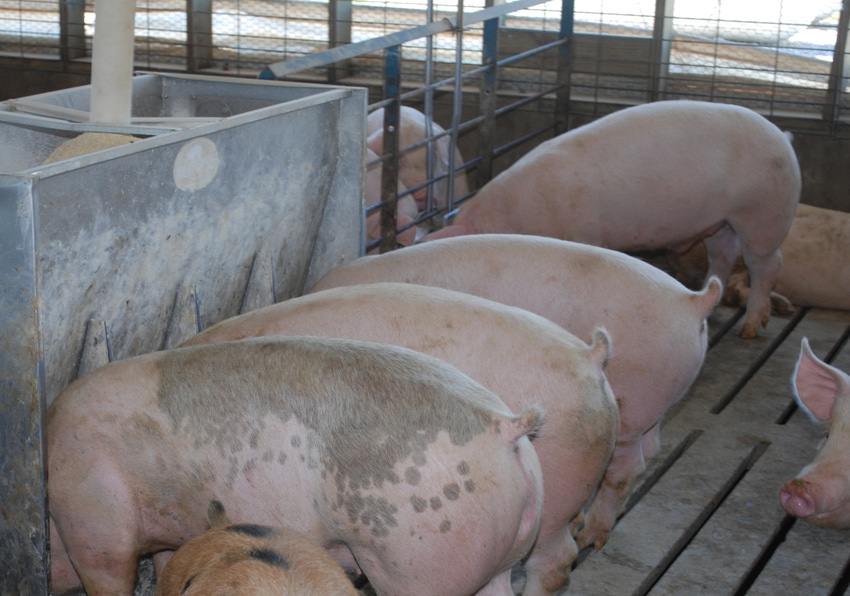University of Minnesota research team evaluates whether using new high-protein dried distillers’ grains in swine diets is really a cost saver for producers.
February 15, 2018

By Zhaohui Yang, Lee J. Johnston, Gerald C. Shurson and Pedro E. Urriola, University of Minnesota Department of Animal Science
The use of corn dried distillers’ grains with solubles in commercial swine diets has increased dramatically because of its relatively high content of energy, digestible amino acids, and phosphorus, resulting in substantial diet cost savings when used as a partial replacement for corn, soybean meal, and inorganic phosphorus. In fact, during most of 2017, DDGS was priced much lower than corn and soybean meal, which led many pork producers to strive for greater diet cost savings by increasing diet inclusion rates to 50 to 60% in grower-finisher diets. However, in doing so, new challenges are emerging to optimize growth performance and carcass composition at these high inclusion rates. Likewise, new technologies are now being implemented in some ethanol plants to produce high-protein corn co-products containing 40 to 50% protein. As a result, the protein content of these high-protein co-products is comparable to that of soybean meal (44 to 48%). While the first reaction may be that the higher protein content may provide greater value and potentially replace a greater amount of soybean meal in swine diets, a more detailed evaluation is needed.
First, results from preliminary studies have shown that the metabolizable energy (ME) content of these new high-protein co-products is equal to or greater than in DDGS, and also greater than the ME content in soybean meal. However, despite the high crude protein content of these new high-protein corn co-products, their amino acid profile and digestibility is inferior to that of soybean meal for meeting the pig’s amino acid requirements. Crude protein is a “crude” measure of the nitrogen content of a feed ingredient that was developed in the 1860’s but is still used today to classify feed ingredients based on “perceived” economic and nutritional value. We have known for several decades that crude protein is a poor measure of amino acid concentration, digestibility, and balance of feed ingredients, especially for corn-based feed ingredients. Therefore, we cannot assume that just because high-protein corn co-products have similar crude protein content with soybean meal, the protein quality and digestible amino acid profile is similar. Relative to soybean meal, corn coproducts supply less lysine (41%), threonine (84%), and tryptophan (35%), while supplying more methionine (140%). Likewise, the digestibility of these amino acids is less than in soybean meal. Fortunately, these deficiencies in digestible amino acid content can be easily overcome by adding adequate amounts of crystalline amino acids to the diet.
In addition to the issues with imbalance and relatively lower digestibility of amino acids, high protein corn co-products have 3 to 5 times greater leucine: lysine ratio than soybean meal. This imbalance among branched chain amino acids increases catabolism of valine and isoleucine and results in reduced feed intake and growth rate of pigs. The excess leucine in high protein corn co-products are of less concern when the co-products are added at relatively low diet inclusion rates (10%), and a significant amount of soybean meal is present in the diet to dilute their concentrations. However, when higher (>10%) diet inclusion rates of high-protein co-products are used along with appropriate amounts of supplemental crystalline amino acids, and most of the soybean meal is removed, the excess leucine relative to valine and isoleucine can reduce growth performance. In fact, the results from one of our recent experiments showed that adding 30% high-protein distillers dried grains to growing-finishing diets decreased ADG compared with feeding a corn-soybean meal diet (Table 1). Diets with high protein distillers dried grains contained 20% more leucine, but similar isoleucine and valine than the corn-soybean meal diet. Therefore, supplementing the high protein distillers dried grain diets with crystalline isoleucine and valine may have corrected this problem, but the cost of these two amino acids is very expensive, and the optimal balance of branch chain amino acids in swine diets is not well established.
Table 1: Effects of adding 30% high protein distillers dried grains on growth performance of growing-finishing pigs

In conclusion, the suboptimal amino acid balance and digestibility of DDGS and high-protein corn co-products requires supplementation of synthetic lysine, threonine, and tryptophan when soybean meal is partially removed from the diet. And feeding high inclusion rates of DDGS (40 to 60%) or high protein co-products (>10%) may require additional supplementation of valine and isoleucine to achieve optimal growth performance of nursery and growing-finishing pigs.
You May Also Like


